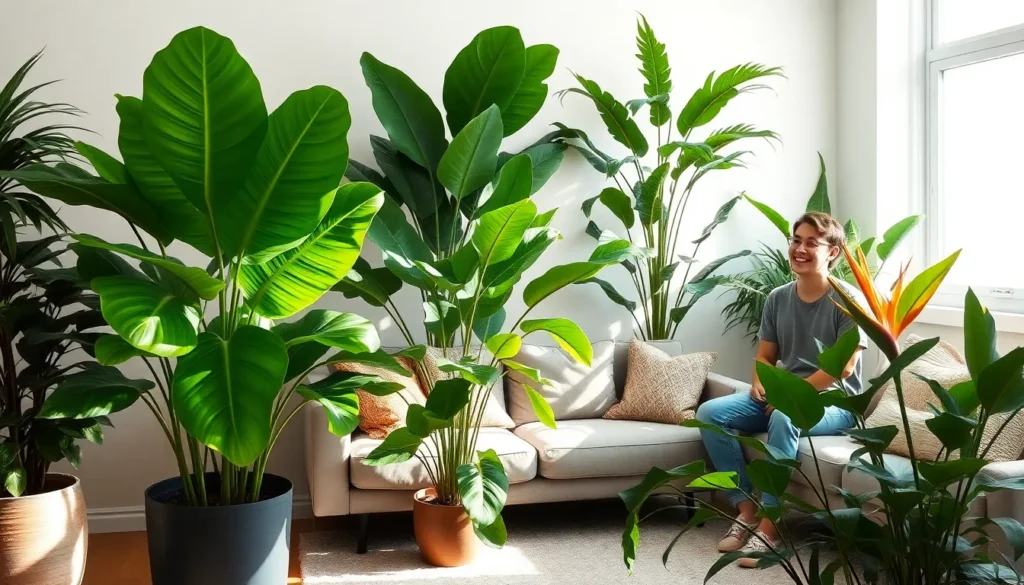We’ve all walked into a living room and felt instantly captivated by towering plants that transform the entire space. Large indoor plants aren’t just decorative elements – they’re architectural features that breathe life into our homes while purifying the air we breathe daily.
The magic happens when we strategically place statement plants in our living spaces. A fiddle leaf fig stretching toward cathedral ceilings or a majestic bird of paradise anchoring a corner creates drama that no furniture piece can match. These green giants make bold design statements while connecting us to nature from the comfort of our couches.
We’re witnessing a plant revolution where bigger truly means better for indoor living. From improving air quality to reducing stress levels these oversized beauties offer benefits that extend far beyond their stunning visual impact. Let’s explore how the right large plants can transform your living room into a lush sanctuary that guests will never forget.
Choose the Right Large Indoor Plants for Your Living Room Space
We’ll explore the essential factors that determine which oversized plants will thrive in your exact living environment. Making informed decisions about plant selection ensures both aesthetic success and healthy growth.
Consider Your Room’s Natural Light Conditions
Bright, indirect light plants transform south and west facing living rooms into lush sanctuaries. We recommend fiddle leaf figs, rubber trees, and monstera deliciosa for these high light spaces since they develop fuller foliage and dramatic presence. These statement plants typically need 6-8 hours of filtered sunlight daily to maintain their architectural appeal.
Medium light tolerant varieties work perfectly in east facing rooms or spaces with filtered windows. Bird of paradise plants, dracaena marginata, and parlor palms adapt well to these conditions while still creating impressive vertical displays. We’ve found these plants maintain healthy growth with 4-6 hours of indirect light.
Low light champions excel in north facing living rooms or areas away from windows. ZZ plants, snake plants, and cast iron plants survive beautifully in dimmer conditions while adding substantial green presence to darker corners. These resilient varieties need only 2-4 hours of ambient light to flourish.
Evaluate Available Floor Space and Ceiling Height
Floor space measurements determine which large indoor plants fit comfortably without overwhelming your living area. We suggest measuring a 3-4 foot diameter circle for spreading plants like bird of paradise or 2-3 feet for upright varieties such as snake plants and rubber trees. This spacing allows proper air circulation and prevents crowding furniture.
Ceiling height considerations directly impact your plant selection since some varieties can reach 8-10 feet indoors. Fiddle leaf figs and rubber trees grow tall quickly in optimal conditions, making them ideal for rooms with 9+ foot ceilings. We recommend pruning or choosing naturally compact varieties like dracaena for standard 8 foot ceiling heights.
Mature size planning prevents future overcrowding issues as your plants establish themselves. Most large indoor plants double or triple their nursery size within 2-3 years, so we factor in this growth when positioning statement pieces. Corner placements work exceptionally well for plants that spread outward like monstera or philodendron varieties.
Match Plant Care Requirements to Your Lifestyle
Low maintenance plants suit busy lifestyles since they require minimal daily attention. ZZ plants, snake plants, and rubber trees tolerate inconsistent watering schedules and still maintain their impressive stature. We water these varieties every 2-3 weeks during growing season and monthly in winter.
Moderate care varieties need regular attention but reward dedicated plant parents with stunning displays. Fiddle leaf figs, bird of paradise, and monstera plants require weekly watering, monthly fertilizing, and occasional misting to reach their full potential. These plants typically show dramatic improvement with consistent care routines.
High maintenance specimens demand daily monitoring and exact environmental conditions to thrive indoors. We recommend plants like calathea varieties and certain palm species only for experienced plant enthusiasts who enjoy hands on plant care. These varieties often need humidity trays, specialized soil mixes, and precise watering schedules.
Position Your Big Indoor Plants for Maximum Visual Impact
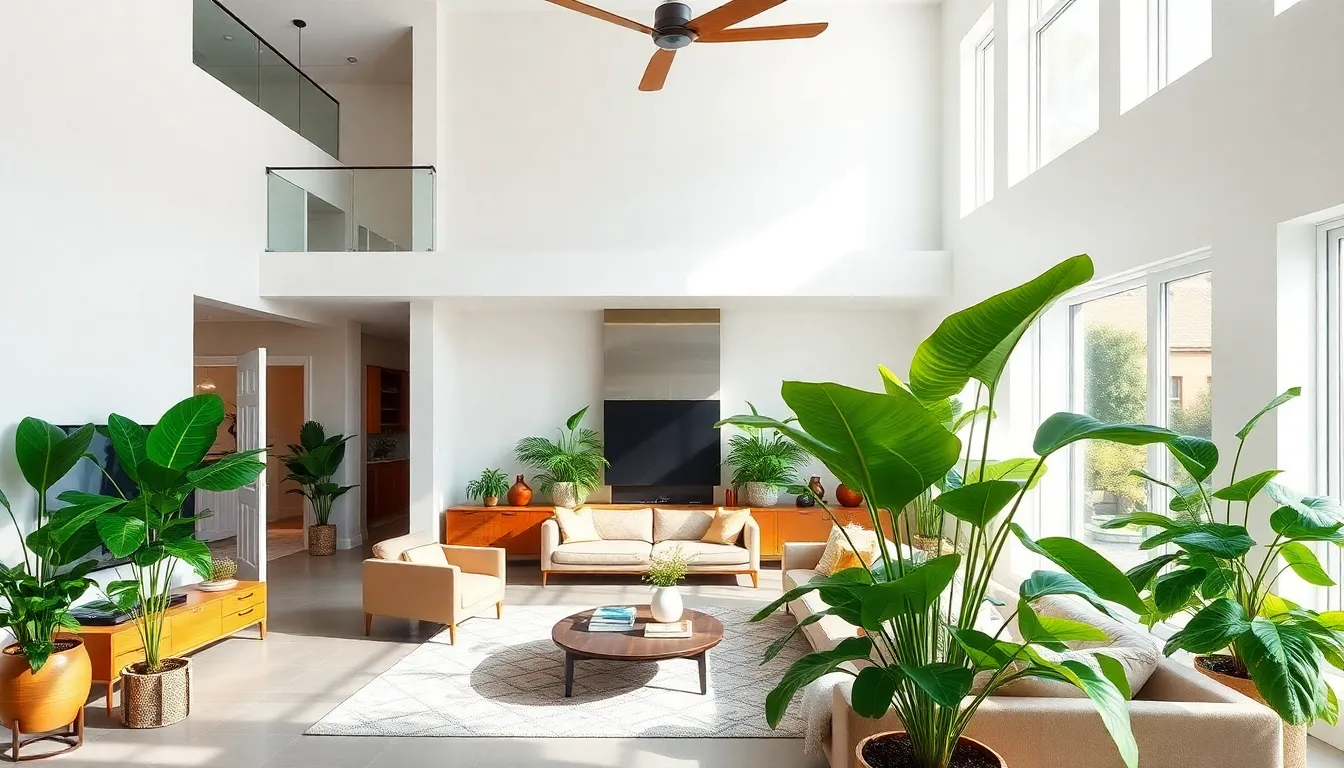
Strategic placement transforms your large indoor plants from simple decor into powerful design elements. We’ll explore how to position these living statements to maximize their visual punch and create harmony throughout your space.
Create Focal Points in Empty Corners
Transform neglected corners into stunning focal points by positioning tall plants like Monstera deliciosa or dracaenas in these underutilized spaces. Empty corners near windows or sofas become natural anchors that draw the eye and eliminate lifeless areas.
Fiddle Leaf Figs and Rubber trees work exceptionally well in bright corners where they can showcase their dramatic foliage. These statement plants need at least 6-8 inches of clearance from walls to ensure proper airflow and visual balance.
Floor plants in corners serve dual purposes by filling awkward dead space while creating natural conversation starters. We recommend choosing plants that match your corner’s exact light conditions for optimal growth and visual appeal.
Use Plants to Define Different Living Areas
Cluster plants in odd numbers like three to visually separate zones within open living rooms without installing permanent barriers. This technique works particularly well for defining reading nooks or lounging areas using plants with similar light requirements.
Large plants function as natural room dividers that maintain an open feel while creating distinct spaces. Position tall palms like Areca or Kentia varieties to subtly separate your dining area from your living space.
Group plants with varying heights to create layered boundaries that feel organic rather than forced. We’ve found that combining floor plants with elevated medium sized specimens on plant stands creates the most effective visual separation.
Balance Plant Placement with Existing Furniture
Scale your plant size to match your room’s proportions by choosing large plants for high ceilinged, spacious rooms while reserving smaller specimens for compact areas. Oversized plants in tiny spaces overwhelm rather than enhance your decor.
Maintain at least three feet between plant tops and ceilings to prevent cramped feelings and allow for natural growth. When plants grow too close to ceilings, we recommend pruning top branches to encourage fuller side growth.
Layer greenery at different heights by placing medium sized plants on shelves or bookcases while keeping small plants on coffee tables or in hanging planters. Plant stands and decorative stools elevate specimens without cluttering precious floor space.
Avoid shoulder to shoulder placement between plants and furniture by ensuring adequate breathing room around each specimen. This spacing prevents overcrowding while allowing each plant’s natural beauty to shine through.
Select Low-Maintenance Large Plants Perfect for Busy Homeowners
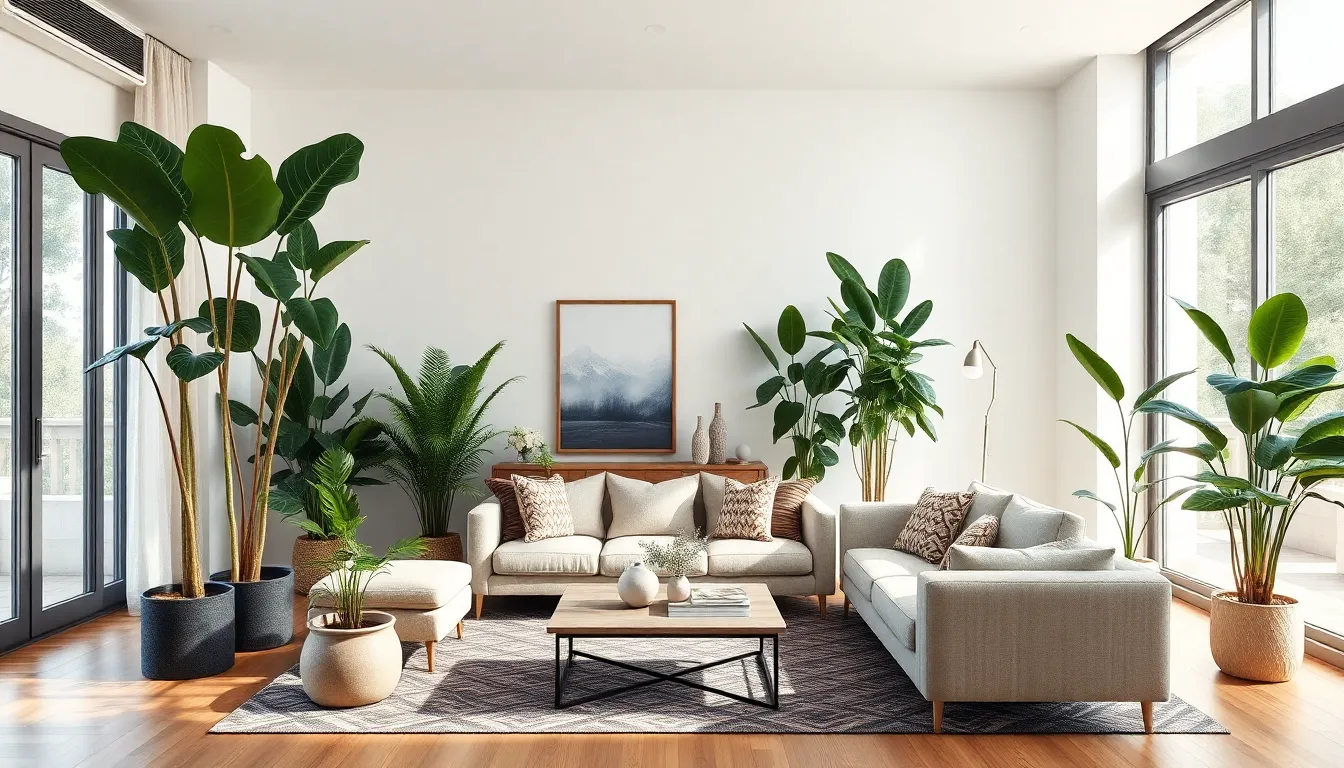
Choosing the right large indoor plants becomes easier when we focus on varieties that thrive with minimal attention. Many established big plants actually require less maintenance because they’re already healthy and settled in their growing patterns.
Fiddle Leaf Fig Trees for Statement Appeal
Fiddle leaf figs create instant drama with their striking large glossy leaves and elegant architectural structure. These plants act as natural focal points in any living room, transforming empty spaces into sophisticated design statements. We love how their broad leaves catch light and create beautiful shadows throughout the day.
Care for fiddle leaf figs requires attention to exact needs, though the visual payoff makes the effort worthwhile. Bright indirect light keeps these plants healthy, while overwatering and drafts can cause leaf drop. Position them near windows with filtered sunlight for optimal growth and that coveted glossy appearance.
Rubber Plants for Easy Care and Growth
Rubber plants excel as beginner friendly options that adapt to various indoor conditions without constant fussing. Their thick waxy leaves and sturdy stems create substantial presence while tolerating different light levels from medium to bright indirect conditions. We appreciate how these plants grow steadily and forgive occasional watering mistakes.
Watering becomes simple when we allow the soil to dry between sessions rather than maintaining constant moisture. Rubber plants actually prefer this approach, making them perfect for homeowners who travel frequently or have unpredictable schedules.
Snake Plants for Low-Light Tolerance
Snake plants thrive in challenging conditions where other large plants might struggle, especially in rooms with minimal natural light. Their sword-like leaves grow tall and architectural, creating vertical interest without requiring prime window real estate. These plants literally survive on neglect, making them ideal for the busiest lifestyles.
Water sparingly by allowing soil to dry completely between watering sessions, sometimes waiting weeks between drinks. This drought tolerance means we can focus on enjoying their sculptural beauty rather than worrying about daily care routines.
Care for Your Large Living Room Plants Like a Pro
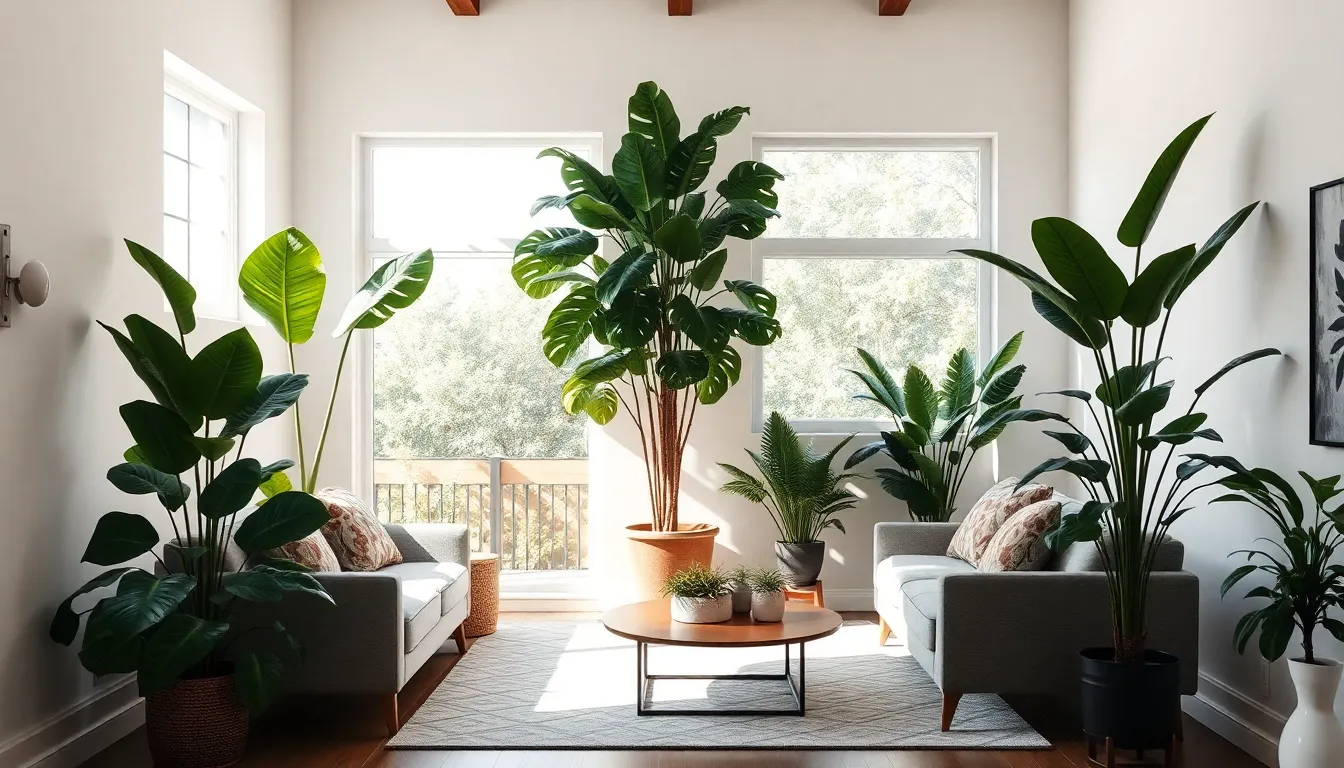
Now that you’ve selected and positioned your statement plants, let’s master the essential care techniques that’ll keep your green giants thriving year-round.
Establish Proper Watering Schedules and Techniques
Watering large plants requires a different approach than caring for smaller houseplants. These giants have bigger pots with larger soil volumes, which means they need watering less frequently—typically every 1 to 4 weeks depending on the species and environmental conditions.
Check the topsoil before every watering session. We recommend testing the first 2-3 inches of soil with your finger to ensure it’s completely dry before adding water. This simple technique prevents the most common cause of plant death: overwatering.
Moisture meters eliminate guesswork from your watering routine. These handy tools provide accurate readings without disturbing the soil structure, making them especially valuable for large plants where digging deep isn’t practical.
Drainage management becomes crucial with oversized containers. Always empty water from saucers within 30 minutes of watering to prevent root rot. We suggest using plant caddies with wheels to move heavy pots easily without straining your back.
Provide Adequate Humidity and Air Circulation
Air circulation prevents fungal problems that commonly affect large indoor plants. Position your plants where gentle air movement occurs naturally, but avoid placing them directly in front of heating vents or drafty windows that might stress them.
Tropical large plants thrive with humidity levels between 40-60%. We recommend using humidifiers during dry seasons or creating pebble trays filled with water beneath your plants to increase local moisture levels without waterlogging the soil.
Strategic placement maintains healthy airflow around your plant collection. Leave adequate space between multiple large plants and walls to ensure proper ventilation reaches all leaf surfaces, reducing the risk of pest infestations and disease.
Recognize Signs of Plant Health Issues Early
Leaf changes signal the first warning signs of plant stress. Monitor your plants weekly for yellowing, browning, or drooping leaves, which typically indicate watering issues, pest problems, or inadequate lighting conditions.
Regular pest inspections catch problems before they spread. We recommend checking the undersides of leaves and stems every two weeks for spider mites, scale insects, or other common houseplant pests that can quickly damage large plants.
Leaf cleaning improves both plant health and appearance. Gently wipe leaves with a soft, damp cloth weekly or give your plants a gentle shower biweekly to remove dust buildup that blocks sunlight and reduces photosynthesis efficiency.
Pruning dead or damaged foliage encourages healthy growth patterns. Remove yellowing or brown leaves immediately using clean, sharp scissors to prevent disease spread and redirect the plant’s energy toward producing new, vibrant growth.
Style Your Big Plants with Decorative Planters and Accessories
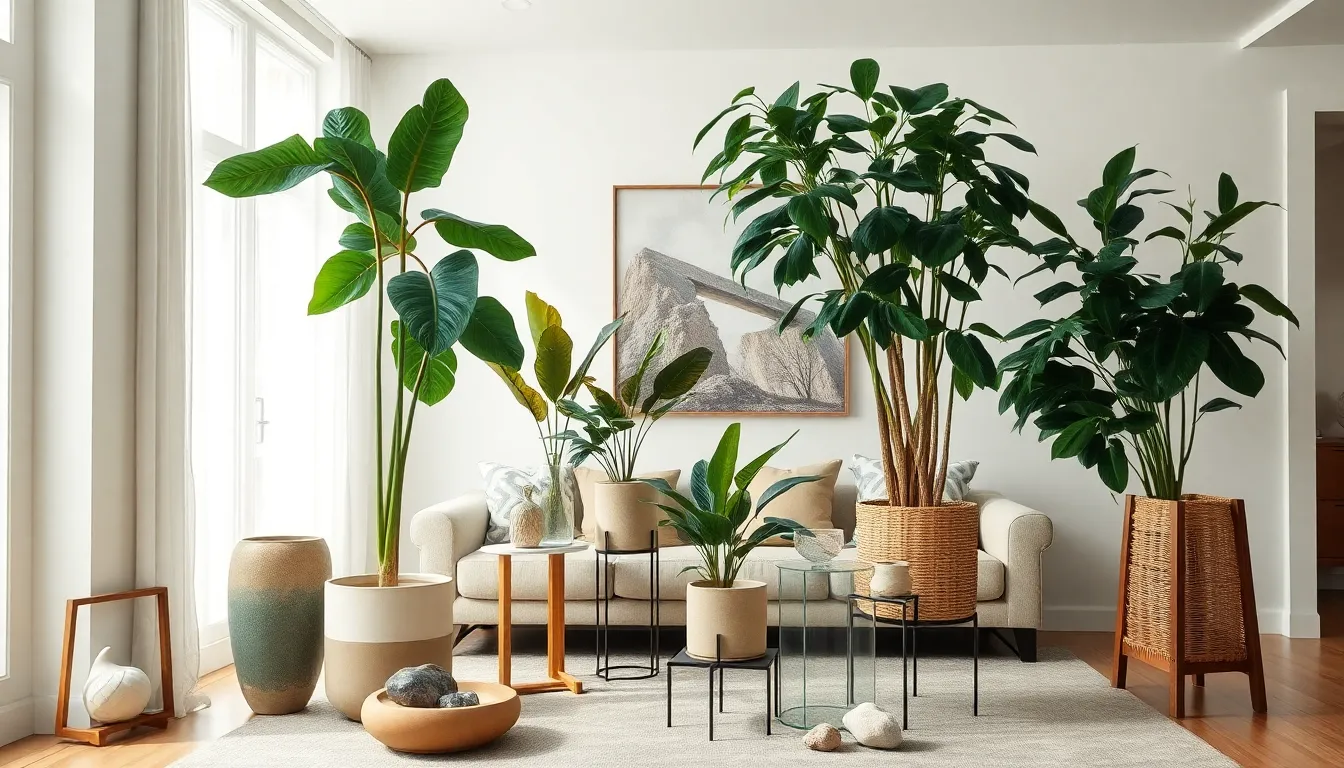
Transform your big indoor plants into stunning design statements by selecting the right planters and accessories that seamlessly integrate with your living room’s aesthetic.
Choose Planters That Complement Your Interior Design
Contemporary planters work beautifully with modern interior styles, featuring clean lines and neutral colors that allow your fiddle leaf figs and rubber trees to take center stage. Minimalist designs in ceramic or concrete complement Scandinavian decor themes, while rustic planters with natural textures enhance bohemian living spaces perfectly.
We recommend exploring retailers like The Sill, Léon & George, and Home Depot for their extensive collections of stylish planters specifically designed for large indoor plants. These sources offer various materials including ceramic, woven baskets, and modern metal options that can elevate both your plant’s appearance and your room’s overall design.
Selecting planters that match your existing color palette creates visual harmony throughout your living space. Neutral tones like white, black, or natural wood finishes provide versatility and allow your snake plants or other large varieties to become the focal point without overwhelming your decor.
Add Plant Stands and Risers for Height Variation
Plant stands create dramatic height differences that draw the eye upward and maximize your living room’s vertical space effectively. Elevated platforms showcase your large indoor plants as striking focal points, transforming empty corners into lush green sanctuaries.
We suggest using risers to create layered displays that add depth and visual interest to your plant arrangements. These tools help you fill awkward spaces while maintaining proper airflow around your plants’ foliage.
Wooden plant stands complement rustic and natural design themes, while metal stands work exceptionally well with contemporary and industrial decor styles. Strategic placement on different levels prevents your large plants from competing for attention and creates a more ever-changing, captivating display.
Incorporate Decorative Elements Around Your Plants
Decorative stones, moss, or mulch on soil surfaces add texture and visual appeal while serving practical purposes like humidity retention for tropical varieties. These natural elements help unify your plants with your room’s existing color scheme and design aesthetic.
We recommend using decorative baskets or trays beneath your planters to protect surfaces from water damage while adding another layer of style. These accessories create cohesive looks that tie your plant displays into your overall interior design theme.
Adding small decorative objects like sculptural pieces or candles around your large plants creates intimate vignettes that showcase your personal style. These thoughtful touches transform simple plant displays into curated design moments that reflect your unique taste and enhance your living room’s welcoming atmosphere.
Solve Common Problems with Large Indoor Plants in Living Rooms
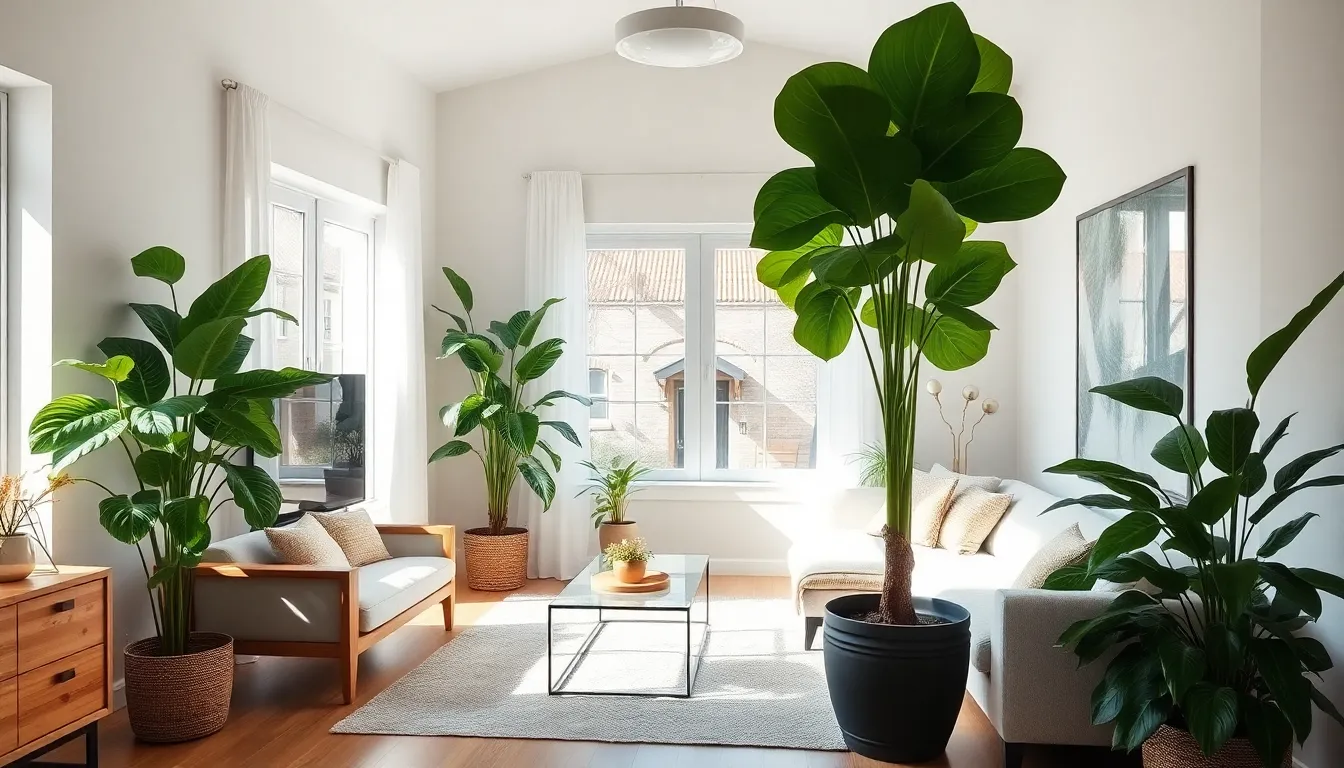
We’ve all experienced the excitement of bringing home a gorgeous large plant only to face unexpected challenges that threaten our leafy investment. Understanding these common issues and their answers ensures our living room plants thrive year-round.
Address Overwatering and Root Rot Issues
Overwatering kills more large indoor plants than any other factor, making it our most critical concern to address. We need to check the top layer of soil before watering and only proceed when it feels dry to the touch.
Proper drainage prevents the vast majority of root rot problems in our living room plants. We should always use pots with drainage holes and well-draining soil to allow excess water to escape. Empty saucers immediately after watering to prevent standing water from accumulating around the roots.
Root rot symptoms appear as wilting even though moist soil and often include a foul smell emanating from the pot. We must act quickly by repotting the affected plant into fresh soil after carefully trimming away any black or mushy roots with sterile scissors.
Prevention strategies work better than treatment when dealing with overwatering issues. We can use moisture meters for accurate soil readings and establish consistent watering schedules based on each plant’s exact needs rather than following rigid calendar dates.
Manage Pest Control in Indoor Environments
Regular inspection of our large plants prevents major pest infestations before they damage the foliage or spread to other plants. We should examine the undersides of leaves weekly for signs of spider mites, aphids, or scale insects.
Natural pest control methods protect our indoor air quality while effectively eliminating unwanted insects. We can wipe leaves with soapy water answers or apply neem oil sprays to affected areas without introducing harsh chemicals into our living spaces.
Air circulation reduces pest problems significantly by creating an environment that’s less favorable for insect reproduction. We should ensure adequate spacing between plants and avoid creating overly humid conditions that attract pests.
Early intervention saves both time and plants when dealing with pest issues. We need to isolate affected plants immediately and treat them away from healthy specimens to prevent the spread of infestations throughout our collection.
Handle Seasonal Changes and Plant Dormancy
Seasonal dormancy affects most large indoor plants during lower light months, requiring us to adjust our care routines accordingly. We should reduce watering frequency and stop fertilizing during dormant periods to prevent root problems and excessive growth.
Pruning during summer months rejuvenates oversized plants and helps us manage their size for better indoor placement. We can trim tops and root the cuttings to create new plants while keeping the original specimen at a manageable height.
Light adjustments become necessary as seasons change and our living rooms receive varying amounts of natural sunlight. We might need to relocate plants closer to windows during winter months or provide supplemental grow lights for optimal health.
Growth patterns slow dramatically during dormancy, making this the perfect time for us to assess plant placement and plan any necessary repositioning. We should avoid major changes to watering or fertilizing schedules until active growth resumes in spring.
Transform Your Living Room into a Green Oasis with Multiple Large Plants
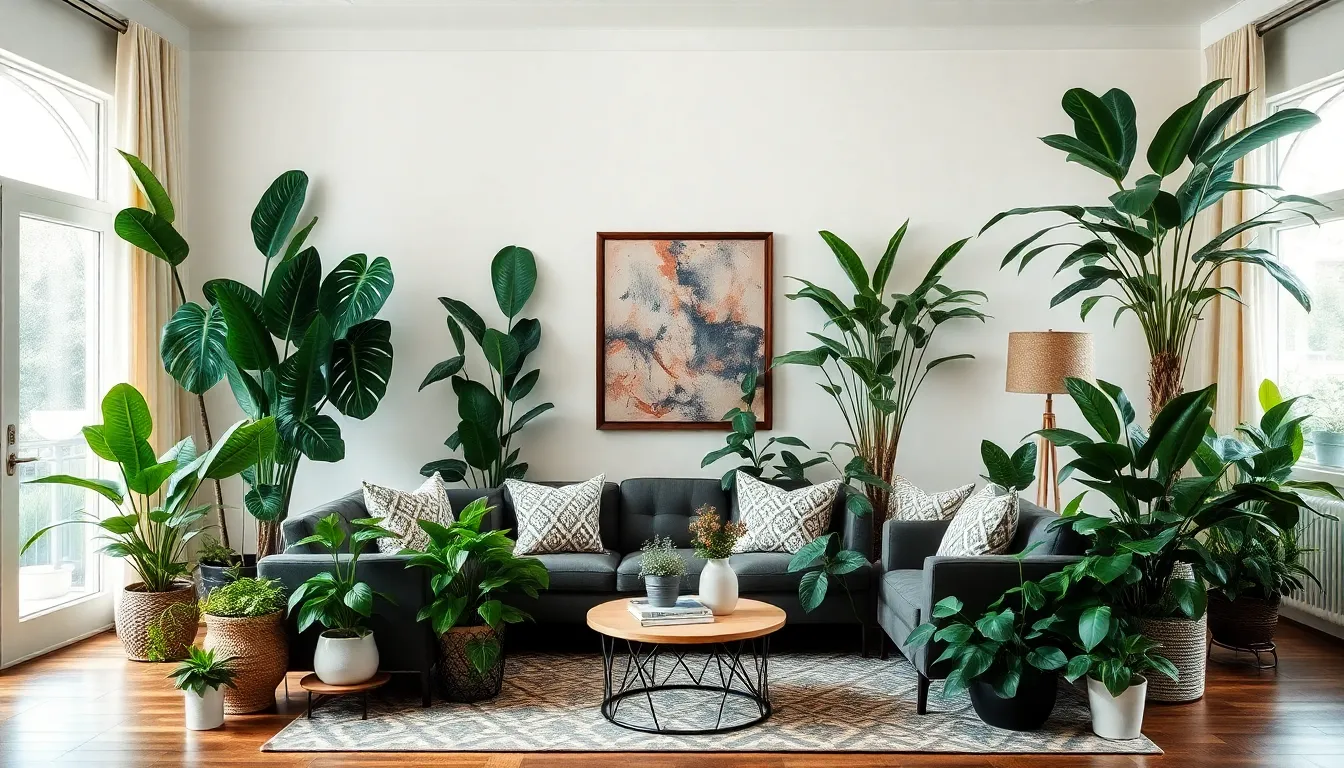
Creating a verdant sanctuary in our living space requires strategic plant placement and thoughtful design choices. Large indoor plants like fiddle leaf figs, rubber trees, and palms such as Areca, Kentia, or Parlor varieties add bold visual impact by introducing height, texture, and vibrant greenery that transforms empty corners into stunning focal points.
Create Layered Plant Arrangements for Depth
Layered plant groupings create dimensional interest that makes our living rooms feel more ever-changing and professionally designed. We position large plants as structural anchors in room corners or wide spaces, then surround them with medium and smaller plants on furniture surfaces or stands to achieve a lush, multi-level effect without overcrowding.
Strategic height variation prevents our plant displays from looking flat or monotonous. Mixing different elevations using plant stands, side tables, and floor placement creates natural visual flow that draws the eye throughout the space. We avoid placing plants shoulder-to-shoulder with furniture or crowding small plants on tabletops to maintain proper visual balance and ensure adequate airflow around each specimen.
The key to successful layering lies in creating breathing room between plant groupings. Each cluster should feel intentional rather than cluttered, allowing individual plants to showcase their unique characteristics while contributing to the overall green industry we’re building.
Mix Different Plant Types for Visual Interest
Combining diverse plant varieties enhances texture contrast and creates captivating visual narratives throughout our living spaces. We mix broad-leafed indoor trees with elegant palms to contrast different shapes and leaf patterns, creating natural variety that keeps our green oasis feeling fresh and inviting.
Complementary plant pairings work exceptionally well when we balance large statement pieces with smaller accent plants. Adding succulents or orchids on coffee tables or shelves introduces finer details and color diversity that prevents our plant displays from feeling one-dimensional. These smaller specimens provide visual rest points between larger focal elements.
Foliage variety becomes our secret weapon for creating sophisticated plant arrangements. We combine glossy-leafed rubber plants with textured fiddle leaf figs and feathery palm fronds to establish natural rhythm and movement that makes our living room feel more connected to the outdoors.
Maintain Proper Spacing Between Large Plants
Proper spacing ensures our large plants have sufficient room to grow and breathe while maintaining the visual impact we desire. Large plants should be positioned at least three feet below the ceiling and fit comfortably within an imaginary 3×3 feet area, preventing overcrowding while allowing necessary maintenance like pruning to encourage healthy side growth.
Adequate spacing prevents our living room from feeling overwhelmed by greenery while ensuring each plant receives proper light and air circulation. We maintain this balance by considering both the current size of our plants and their mature growth potential when planning our arrangements.
Room flow remains unobstructed when we strategically space our large plants away from high-traffic areas. This thoughtful placement protects both our plants and our daily movement patterns while maximizing the visual benefits these green giants bring to our living spaces.
Conclusion
We’ve explored how big plants can completely transform your living room into a stunning green sanctuary. From selecting the right varieties for your exact light and space conditions to mastering proper care techniques these oversized beauties offer endless possibilities for improving your home’s aesthetic appeal.
The key lies in thoughtful placement strategic styling and understanding each plant’s unique needs. Whether you’re drawn to low-maintenance options like snake plants or ready to invest time in fiddle leaf figs the right large indoor plant will become a living centerpiece that brings natural elegance to your space.
Your living room deserves the dramatic impact that only statement plants can provide. With proper planning and care you’ll create an inviting environment that showcases your personal style while enjoying the wellness benefits these green companions bring to your daily life.
Frequently Asked Questions
What are the main benefits of having large indoor plants in my living room?
Large indoor plants serve as natural air purifiers, removing toxins and increasing oxygen levels. They also reduce stress, create a calming atmosphere, and act as stunning decorative focal points. These statement plants can transform empty corners into lush sanctuaries while connecting you to nature indoors.
How do I choose the right large indoor plant for my living room?
Consider three key factors: available natural light, floor space, and ceiling height. Match plants to your light conditions—fiddle leaf figs for bright spaces, ZZ plants for low light. Measure your space to avoid overcrowding and ensure the plant fits comfortably without touching the ceiling.
Which large indoor plants are best for beginners or busy people?
Snake plants, rubber plants, and ZZ plants are excellent low-maintenance options. Snake plants tolerate low light and infrequent watering, rubber plants adapt to various conditions, and ZZ plants are extremely drought-tolerant. These varieties forgive occasional neglect while still making impressive statements.
Where should I place large indoor plants for maximum visual impact?
Transform empty corners into focal points with tall plants like Monstera deliciosa or dracaenas. Use plants to define different areas in open spaces by clustering them in odd numbers. Ensure proper spacing between plants and furniture for airflow and visual balance.
How often should I water my large indoor plants?
Check the topsoil before watering—most large plants prefer soil to dry out slightly between waterings. Generally, water every 1-2 weeks, but frequency depends on plant type, season, and humidity levels. Use a moisture meter for accurate readings and always ensure proper drainage.
What are the most common problems with large indoor plants and how do I prevent them?
Overwatering leading to root rot is the biggest issue. Ensure proper drainage and consistent watering schedules. Watch for pest infestations by regularly inspecting leaves. Adjust care routines seasonally, reducing watering and fertilizing during winter dormancy periods.
How can I style my large indoor plants to match my home decor?
Choose planters that complement your existing decor style—ceramic for contemporary, woven baskets for rustic, or sleek metal for minimalist looks. Use plant stands and risers to create height variation. Add decorative elements like stones or moss to enhance the overall aesthetic appeal.
Do large indoor plants really improve air quality?
Yes, many large indoor plants are natural air purifiers. Plants like rubber trees, fiddle leaf figs, and snake plants remove common household toxins such as formaldehyde and benzene while releasing oxygen. NASA studies confirm that indoor plants significantly improve air quality in enclosed spaces.

